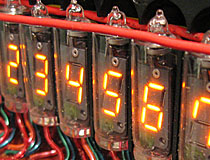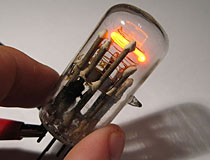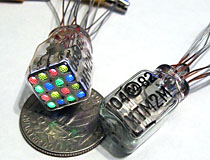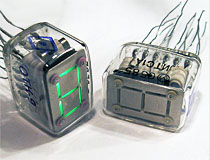
 |
| Nixie & Gas Discharge Displays |
Gas discharge displays are low pressure neon lamps with multiple, shaped or shape-shaded cathodes. Tubes in this family include Nixie, Pixie and Panaplex displays, as well as more exotic technologies like gas thyratron and Self-Scan displays. |
|
| Burroughs 4021L & 7977 | |
Devices included in this entry: A related device is the Burroughs 7977 Nixie tube, which has an identical internal construction and envelope to the 4021, but is encased in a black silicone sleeve to reduce back-lighting of the displayed digit. The 7977 is designed to be used with a socket, and lacks the flying leads of the 4021L. |  |
| Rodan Elfin MG-17F & MG-17G | |
The MG-17F represents a point of transitional evolution for neon displays; a short lived period where manufacturers began to switch to flat segmented displays, but still packaged them in tubular envelopes. Unlike other Nixie tubes, the MG-17F does not have stacks of shaped cathodes to form it's digits. Instead simple bar cathodes are arranged to form a seven segment pattern. This tube has upper and lower decimal points, allowing it to be mounted normally or with the leads exiting the top of the envelope. Despite being a transitional device, the MG-17F saw use in a number of consumer products, most likely due to lower manufacturing costs when compared to competing stacked cathode Nixie tubes. Rodan also produced the MG-17G, a variant of this tube with smaller digits and only a single decimal point. The MG17-G lacks the front anode screen present in the MG-17F, resulting in a brighter and more visible display. The MG-17F and MG-17G were both released in 1969, and competed directly with first generation LED displays like the Monsanto MAN1. |  |
| National Union GI-10 Inditron | |
The GI-10 'Inditron' is an historical curiosity, a Nixie-style numerical indicator tube which was developed in parallel to the more successful Burroughs Nixie, and may actually predate the Burroughs Nixie by as much as a year. Beginning in 1954, National Union produced a small number of neon-filled indicator tubes which used bent wire cathodes to indicate a numeric value. The tubes had very short operational lifespans and were difficult to drive with the then existing technology, which prevented widespread use and ultimately doomed the tube to failure in the market. |  |
| Melz ITM2M | |
The ITM2M (also sometimes called the ITM2-M) is a strange device, a Soviet-manufactured indirect gas discharge display. Like a Nixie, the ITM2M is filled with low pressure ionizing gas, but all similarities to more common displays end there. ITM2M tubes contain an array of 16 tiny thyratrons, each painted with one of four colored phosphors. Activating one of the thyratrons causes the gas within to ionize, resulting in illumination of the associated phosphor. These tubes have complex power supply requirements and must be supplied with separate -300VDC, 150VDC, and 75VDC signals to function properly. However, once those needs are met, individual rows and columns are self-latching and can be controlled with a low voltage 10VDC signal due to the switching action of the internal thyratrons.The ITM2M is packaged in a tiny cubical envelope, allowing for the construction of large tiled displays. |  |
| Melz ITS1A | |
Another very unusual Soviet tube, the ITS1A is an indirect gas discharge display configured for seven-segment number generation. Despite appearances the ITS1A is closer to a Nixie tube than a VFD; the device contains seven gas thyratrons, one for each segment, which are painted with green phosphor. When the tube is energized with a high voltage source and a given thyratron is triggered, the neon fill gas will ionize and excite the phosphor in the triggered segment, producing a piercing green glow. As with the ITM2M display shown above, these tubes have complex power supply requirements and must be supplied with separate -300VDC, 100VDC, and 50VDC signals to function properly. Once these needs are met the tube can be controlled with a 5VDC signal, resulting in a neon display that can be directly attached to a microcontroller with no intermediate hardware. The ITS1A is also self-latching, which eliminates the need to multiplex large displays. Related: An ITS1A 'Thyratron' Clock Project |  |
| ETL GR10A | |
Though it resembles a dekatron, the GR10A is actually a register tube - basically a Nixie or Pixie tube shaped like a dekatron. Register tubes were designed to provide a consistent display when dekatrons were used in conjunction with beam switching tubes or hard valve decades in the same counter. The visible glow extinguishes above ~50 kHz, and reappears at lower speeds. |  |
| ©2000-2025 Industrial Alchemy. All rights reserved. | Switch to mobile version | Contact | |  |